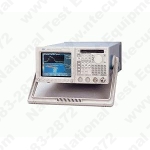Contact us for pricing and availability.
Description
Features
2 MHz Real-time Signal Capture
Simultaneous Time and Frequency Domain Capture
50 Hz to 3 GHz Frequency Coverage
Frequency, Time and Phase Analysis
25,000 Frames/Second Measurement Speed
Display Update Rate of 40 Microseconds
Applications
Cellular/PCS Manufacturing Test
Pager Manufacturing Test
RF Component Manufacturing Test Including DLL and Synthesizer Settling
Network Ingress Monitoring and Analysis
CATV Return-path Ingress Monitoring
Radar System Fault Location and Maintenance
Time and Code Domain Consumer Product Manufacturing Test
Microwave Data Link Fault Location
Computer Manufacturing/Test for EMC
Surveillance
Performance Verification of Consumer Products that Use Time or Code Domain Commands
The new 3026 real-time Spectrum Analyzer provides design engineers and manufacturing final test evaluators of communications equipment an affordable product that can be used to quickly evaluate a design or the final product for transient (Burst) phenomena that otherwise might not show up until it is in the end user's hands.
The 3026 offers a full 2 MHz of real-time bandwidth with measurement speed of 25,000 frames/second and a 1024 point update interval of 160 microseconds. The captured events can be conveniently displayed in a variety of formats selectable by the user: Spectrum, Spectrogram and Waterfall. The analyzer architecture makes it possible to capture time domain data and frequency domain data simultaneously.
To catch instantaneous phenomenon like a transmitter startup, or the beginning of a digital TDMA or CDMA transmission, the 3026 provides frequency domain and time domain real-time triggering with a mask pattern that is easily edited in the built-in editor.
The 3026 consists of a 3 GHz down converter unit which converts the RF signal to IF, the A/D converter which converts analog signals to digital, the digital down converter (DDC) which down-converts the center frequency and changes the span, the real-time FIFO which frames the data stream, the FFT processor which extracts the spectrum components, a memory system which captures the time and frequency domain data, and the system controller which covers the user interface and hardware control.
The system architecture is based on the ISA bus. The instrument software operates under the VxWorks. Instrument controls and functions are implemented in C language. The display is a 6.5 in. VGA TFT-LCD. The 3026 includes a 3.5 in. floppy disk unit and 1.5 GB hard disk drive. GPIB and Ethernet interface are standard along with a parallel printer port.
3026 with its real-time analysis capability has much to offer:
Greater ability to measure PLL lock time
Frequency trigger for capture of CDMA burst when in low speech rate mode
Fast measurement of transmitter power
Capture of transient or intermittent signals
Phase jump measurement capability
Fast file transfer via Ethernet
Simultaneous capture of frequency and time domain characteristics of signals
Color spectrogram
Application Examples
Digital Cellular/PCS Design, Test and Manufacture
Current spectrum analyzers do not do a very good job of analyzing burst or intermittent signals. They sweep over a band of frequencies and are therefore not able to capture simultaneously the spectrum over a band of frequencies. This makes it difficult, or sometimes impossible, for a developer to identify problems, such as phase jumps, which will adversely affect a digitally modulated system.
Transient noise burst problems that are often associated with high frequency solid state communications equipment can be captured with a measurement speed of 25,000 frames/second and a 1024 point update interval of 160 microseconds reducing intermittent problem test time.
EMC
Common Carrier and CATV Network operators have to deal with Ingress that can disrupt transmission in both the forward and return paths. This interference is often impulsive in nature and very difficult to capture with a conventional spectrum analyzer. The 3026 with its real-time capture capability allows rapid detection and analysis of such interference.
In the screen photo (1) (lower section of photo) below an interfering burst 4.8 MHz above the spectrum center is captured for analysis. In the upper spectrogram section the amplitude vs. frequency of the complete spectrum is displayed as a function of time (vertical axis).
Specifications & Attributes (Spectrum Analyzers)
| Form Factor |
|---|
| Benchtop |
| Portable |
| Frequency |
|---|
| 10 MHz - 3 GHz |
